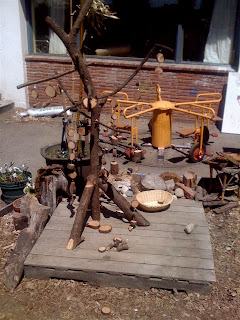Here are some more stories from the kids.
Once there was two silly glasses. They they bonked inside a mirror and a forehead. And then there was a big monster that ate everything, but not poison, fire, and ice. And then he forgot because he ate ice, and he stayed as a statue. --Jack
Once there was a pencil. And then it poked everything except the compliment chain. And then it lift him up and splatted on the face. Then they went home. --Jack
It's a angry one. There was two ghost-es. And one was a kid. And then one was a boy. And there was another monster skeleton. And then there was another monster. --Lachlan
About a monster. The monster hit a monster. And then another monster and then it bumped my pants. An dthe it bumped me. Then it bumped Teacher Tom. And then it bumped Lachlan. And then it bumped that's the end. --Lachlan
The robot was silly. Then the silly rabbit came. Then the snow. And then they put on some warm clothes. And then they climbed on a tree. And then the snow fell down again. The snow fell down again. And then they climbed on the slippery slide. And then they went ice skating. --Anjali
There was a elephant jumping on your head. There was a cow jumping on your head too. And then there was a camera jumping on a bike. --Dennis
There was a pig jumping on your head. And there was sheep jumping on your light. And there was a elephant jumping on your elbow. And there was a elephant jumping on your face. And there was a elephant jumping on your arms . . . on your head . . . on your scarf . . . on a eyeball. Tiger jumping on your ankle. There was a light jumping on your apple. Sheep jumping on your apple. --Dennis
A frog that eats mushrooms. --Orlando
A dark, dark night. --Orlando
Christmas Lights
One foggy winter when there was snow and it was Christmas. And we built a snowman. And then we made snowballs and we throwed them. And the we sleeped inside by the fire. --Katherine
The little puppy goed and had some food. And why he did that he ate a paint brush at the same time he had his food. Then he goed outside, chased a squirrel and ate it. And then he squirrel was still alive and ran away. --Katherine
Alligator. Then alligator chased a mouse. It chased it away and eat a kids. Then alligator ate a paper and then it got sick. And then Finn was away and he got hurt. --Charlie B.
Once there was a scary guy. And he scared the bunny away. And he was going to tag the bunny. And he was going being silly. And he scared the ghost away. And he scared Jack away and after ever after. The end. --Marcus
A cat found a ghost. And it ran away. Then he found some glasses. Then the cat ran away from the glasses. Then he ran to a window. --Luna
About a little unicorn and a little kitty. And they played together and played together until the sun set. And then they played, played, played until it's time to go in and they had a nice supper. And all the kitties and unicorns were snug in their beds. --Ella
Christmas time is here right now. Santa gave me a present that was like the coolest one. And then he give me a new army shirt. And then he gave me army pants. And then he gave me a army carrier boat. And then he got me a army helicopter. And then he gave me new lights. And then he gave me a race track that comes with cars. And then he got me a new trike. And then he got me a new race track that's super big. I went in the store. --Finn V.If you're interested in our storytelling process, that post is here.
If you're interested in other stories from the kids, here they are in the order in which I've transcribed them:






















































